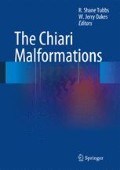Abstract
Since the early nineteenth century, some authors have used the term syringomyelia to describe any tubular cavity within the spinal cord. More recently, classification systems have evolved to describe syringomyelia subtypes as well as distinguish other entities such as hydromyelia, syringobulbia, and myelomalacia. Our current understanding of the etiology of syringomyelia, although more advanced, is still incomplete. Syringomyelia occurs in many different clinical settings with variable clinical symptomatology and different cavitary patterns. Anatomic and pathologic criteria are helpful in establishing basic classification of syringes as well as understanding syringomyelia in the setting of Chiari malformation. The pathophysiological hypotheses for syringomyelia are numerous, controversial, and variable according to the proximate cause. The gross pathology and histology are similar irrespective of cause, and competing theories continue to evolve on the pathogenesis of syrinx formation.
Access this chapter
Tax calculation will be finalised at checkout
Purchases are for personal use only
References
Bielschowsky M, Unger E. Syringomyelie mit Teratom-und extramedulla¨ rer Blastom-bildung. J Psychol Neurol (Lpz). 1920;25:173–218.
Chang HS, Nakagawa H. Hypothesis on the pathophysiology of syringomyelia based on simulation of cerebrospinal fluid dynamics. J Neurol Neurosurg Psychiatry. 2003;74:344–7.
Chang HS, Nakagawa H. Theoretical analysis of the pathophysiology of syringomyelia associated with adhesive arachnoiditis. J Neurol Neurosurg Psychiatry. 2004;75:758–64.
Chern JJ, Gordon AJ, Mortazavi MM, Tubbs RS, Oakes JW. Pediatric Chiari malformation type 0: a 12-year institutional experience. J Neurosurg Pediatr. 2011;8:1–5.
Ellertsson AB. Syringomyelia and other cystic spinal cord lesions. Acta Neurol Scand. 1969;45:403–17.
Ellertsson AB, Greitz T. The distending force in the production of communicating syringomyelia. Lancet. 1970;1:1234.
Feigin I, Ogata J, Budzilovitch G. Syringomyelia: the role of edema in its pathogenesis. J Neuropathol Exp Neurol. 1971;30:216–32.
Foster JB, Hudgson P. The pathology of communicating syringomyelia. In: Barnett HJM, Foster JB, Hudgson P, editors. Syringomyelia. Philadelphia: WB Saunders; 1973. p. 79–103.
Gardner WJ, Goodall RJ. The surgical treatment of Arnold-Chiari malformation in adults: an explanation of its mechanism and importance of encephalography in diagnosis. J Neurosurg. 1950;7:199–206.
Gardner WJ, Angel J. The cause of syringomyelia and its surgical treatment. Cleve Clin Q. 1958;25:4–8.
Gardner WJ, Angel J. The mechanism of syringomyelia and its surgical correction. Clin Neurosurg. 1959;6:131–40.
Gardner WJ. Hydrodynamic mechanism of syringomyelia: its relationship to myelocele. J Neurol Neurosurg Psychiatry. 1965;28:247–59.
Greitz D, Ericson K, Flodmark O. Pathogenesis and mechanics of spinal cord cysts: a new hypothesis based on magnetic resonance studies of cerebrospinal fluid dynamics. Int J Neuroradiol. 1999;5:61–78.
Heiss JD, Patronas N, DeVroom HL, Shawker T, Ennis R, Kammerer W, et al. Elucidating the pathophysiology of syringomyelia. J Neurosurg. 1999;91:553–62.
Hinokuma K, Ohama E, Oyanagi K, Kakita A, Kawai K, Ikuta F. Syringomyelia: a neuropathological study of 18 autopsy cases. Acta Pathol Jpn. 1992;42:25–34.
Klekamp J, Samii M. Syringomyelia: diagnosis and treatment. Berlin: Springer; 2002.
Klekamp J. The pathophysiology of syringomyelia – historical overview and current concept. Acta Neurochir. 2002;144:649–64.
Levine DN. The pathogenesis of normal pressure hydrocephalus: a theoretical analysis. Bull Math Biol. 1999;61:875–916.
Levine DL. The pathogenesis of syringomyelia associated with lesions at the foramen magnum: a critical review of existing theories and proposal of a new hypothesis. J Neurol Sci. 2004;220:3–21.
Levy EI, Heiss JD, Kent MS, Riedel CJ, Oldfield EH. Spinal cord swelling preceding syrinx development. J Neurosurg. 2000;92:93–7 (Spine 1).
Liber AF, Lisa JR. Rosenthal fibers in non-neoplastic syringomyelia. J Nerv Ment Dis. 1937;86:549–58.
Milhorat TH, Kotzen RM, Anzil AP. Stenosis of central canal of spinal cord in man: incidence and pathological findings in 232 autopsy cases. J Neurosurg. 1994;80:716–22.
Milhorat TH, Capocelli Jr AL, Anzil AP, Kotzen RM, Milhorat RH. Pathological basis of spinal cord cavitation in syringomyelia: analysis of 105 autopsy cases. J Neurosurg. 1995;82:802–12.
Milhorat TH, Capocelli AL, Kotzen RM, et al. Intramedullary pressure in syringomyelia: clinical and pathophysiological correlates of syrinx distension. Neurosurgery. 1997;41:1102–10.
Milhorat TH. Classification of syringomyelia. Neurosurg Focus. 2000;8(3):1–6.
Moriwaka F, Tashiro K, Tachibana S, Yada K. Epidemiology of syringomyelia in Japan—the nationwide survey. Rinsho Shinkei-gaku-Clin Neurol. 1995;35:1395–7.
Netsky MG. Syringomyelia: a clinicopathologic study. Arch Neurol Psychiatry. 1953;70:741–77.
Oldfield EH, Muraszko K, Shawker TH, Patronas NJ. Pathophysiology of syringomyelia associated with Chiari I malformation of the cerebellar tonsils. J Neurosurg. 1994;80:3–15.
Rossier AB, Foo D, Shillito J, Dyro FM. Posttraumatic cervical syringomyelia. Incidence, clinical presentation, electrophysiological studies, syrinx protein and results of conservative and operative treatment. Brain. 1985;108:439–61.
Tubbs RS, Elton S, Grabb P, Dockery SE, Bartolucci AA, Oakes WJ. Analysis of the posterior fossa in children with the Chiari 0 malformation. Neurosurgery. 2001;48:1050–5.
Williams B. The distending force in the production of “communicating syringomyelia”. Lancet. 1969;2:189–93.
Williams B. Current concepts of syringomyelia. Br J Hosp Med. 1970;4:331–42.
Williams B. On the pathogenesis of the Chiari malformation. Z Kinderchir Grenzgeb. 1977;22:533–53.
Williams B. Simultaneous cerebral and spinal fluid pressure recordings: 2. Cerebrospinal dissociation with lesions at the foramen magnum. Acta Neurochir. 1981;59:123–42.
Williams B. Pathogenesis of syringomyelia. In: Batzdorf U, editor. Syringomyelia: current concepts in diagnosis and treatment. Baltimore: Williams & Wilkins; 1991. p. 59–90.
Harding BN, Copp AJ. Pathology of malformations. In: Love S, Louis DN, Ellison DW, editors. Greenfield’s neuropathology. 8th edn. London: Hodder Arnold; 2008. p. 429–33.
Author information
Authors and Affiliations
Corresponding author
Editor information
Editors and Affiliations
Rights and permissions
Copyright information
© 2013 Springer Science+Business Media New York
About this chapter
Cite this chapter
Harrison, D.K. (2013). Pathology of Syringomyelia Due to Chiari Malformations. In: Tubbs, R., Oakes, W. (eds) The Chiari Malformations. Springer, New York, NY. https://doi.org/10.1007/978-1-4614-6369-6_9
Download citation
DOI: https://doi.org/10.1007/978-1-4614-6369-6_9
Published:
Publisher Name: Springer, New York, NY
Print ISBN: 978-1-4614-6368-9
Online ISBN: 978-1-4614-6369-6
eBook Packages: MedicineMedicine (R0)

